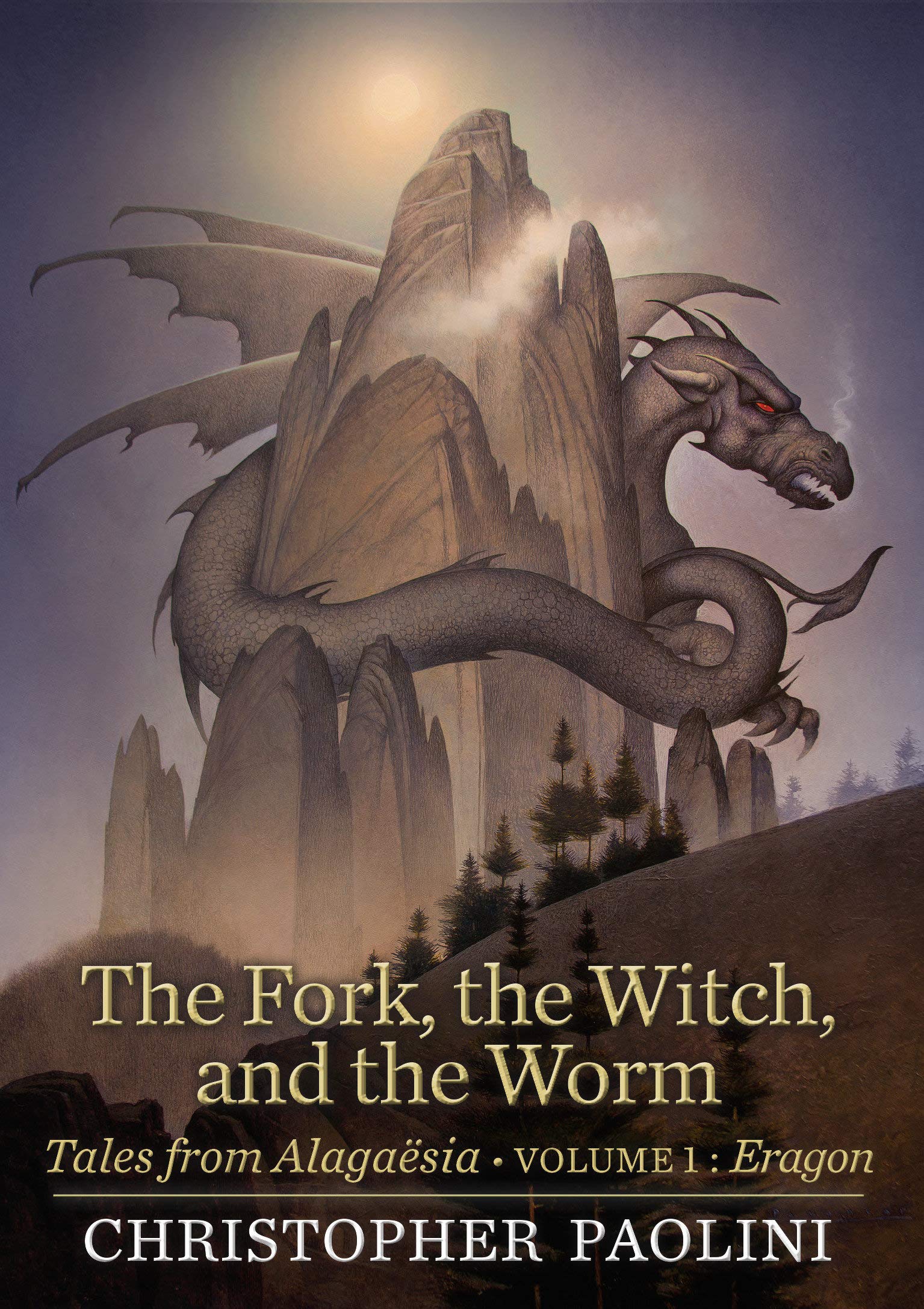The Fork, the Witch, and the Worm: Checking in On Christopher Paolini’s Eragon
Eight years after the last book in the Inheritance Cycle series, Christopher Paolini publishes a new short story collection.
I had a thought last year– what has Christopher Paolini, author of the Inheritance Cycleseries, been up to lately? A quick Google search told me nada. Then, at the very end of last year came a collection of short stories, set in the world of Alagaesia and a brief look at what our main character Eragon was up to, as well as telling some new stories set in that world.
It’s important to understand going in that this isn’t a singular story, and shouldn’t be held to the standards of holding up as a true sequel to the conclusion of the Inheritance Cycle. Holding it to such standards would leave the reader wanting much more from this, rather than enjoying the simple ride this collection presents.
Read Eragon: Inheritance, Book 1 by Christopher Paolini
The Inheritance Cycle was about Eragon, simple farm boy-turned-Dragon Rider set in the magical world of Alagaesia. It was a classic fantasy story, rife with warring factions and an evil Dragon Rider who ruled with an iron first. The world building was lovely, the characters memorable and the stakes high. It took four hefty tomes to tell Eragon’s story and the last book was published in 2011, so it’s been a while since we’ve heard from either Eragon or author Christopher Paolini, who hadn’t published anything until this time.

The Fork, the Witch, and the Worm is three stories set within the world of Alagaesia, bookended by what Eragon is up to these days. It both elaborates upon the world while continuing to leave many mysteries, drawing attention to the fact that this collection is subtitled “Volume 1: Eragon.” It appears to hint that other books revolving around pivotal characters may follow.
The volume is divided in three major parts. Eragon leads and then wraps up each part, gaining a lesson or two from the process while he deals with being the leader of a new settlement. So, no, this isn’t Beedle the Bard: Alagaesia Edition, but it’s own thing. It’s a pretty brief read, all but for the last part which goes in depth on a folk tale.
There are several ideas I would have liked explored further in this book, or at least touched upon. I feel like a missed opportunity exists where the author could have given us a glimpse at when Alagaesia was discovered. Numerous clans and creatures talk about when their kind sailed into the land many lifetimes ago, but we don’t know where they came from or why they came to Alagaesia. Perhaps this can be elaborated on in a further installment.
Stepping into this new volume had a general air of excitement. The reader, familiar with the world already, could finally revisit. It’s like the Narnia kids having a long reprieve from their magical world until a new portal opens in an unexpected place.
Further reading: 9 Fantasy Books Set At Magical Boarding School
It doesn’t quite fill the gap where a full book would fit. The three parts of the book are like snapshots. Eragon, dealing with the pressures of leadership, is shown three different stories that are meant to teach and guide him. One is a glimpse at an old friend in a land far away, teaching a life lesson to a young girl. Another features the partial memoir of herbalist Angela and the third is a folktale told by an Urgal (a horned creature in this world).
The format eliminates the ability to go too deep into meaning and shock value. The parts with Eragon are brief enough to feel like snapshots (20 pages at the most) so that his very real problems of running a settlement are mostly just touched upon.
There is a scene in which Eragon must address a cave-in that injures some of his people: “For all the spells he had learned and powers he had gained since becoming a Dragon Rider — and for all the strength of the dragons — some things were still beyond him.” It’s an important lesson to learn, and an important facet showing that Eragon still has growing to do as a character. He’s not perfect, he’s no Mary Sue (or Marty Stu, as the male version is sometimes called) and he has to learn the hard way that not all problems are easily answered or solved at all. Does this hold the amount of weight that could have been explored in a novel format? No, but it does the job it’s meant to do.
Further reading: An Author Interview with S.L. Huang
An interesting feature of the book is a partial memoir from Angela the herbalist, written not by Christopher Paolini but his sister Angela Paolini, whom the character was initially based on. This gave a new voice to read into, but a perplexing memoir.
In the section “On the Nature of Stars” where Angela states: “The tales contained in this volume are all true, and every one is false.” It’s commentary on the memoir Angela tells, but may further describe the book itself. We don’t truly know if the folk tale at the end of the book “The Worm of Kulkarus” is a true story, or whether the peculiar Angela is actually writing a memoir or blatantly lying. The only story we assume is true is the first one “The Fork” which is shown to Eragon via his dragon friends. Perhaps, truly, Angela is saying something more meta. That if you don’t care for this book, don’t count it as canon for the series. Bold move, Paolini’s.
WIth the release of The Fork, the Witch, and the Worm arriving eight years after the last book in the Inheritance Cycle series was published, It seems Paolini is almost living up to GRRM level book release times. Luckily that doesn’t appear to be the case. The author has teased on his website a “massive sci fi novel” that is intended to be published by the end of this year.
Further reading: Den of Geek’s Best Fiction Books of 2018
In the meantime, this collection brought back fond memories and a breath of fresh air. It didn’t have to be perfect. Nobody asked it to. It left this reader yearning for more, perhaps a new story told in a multi-book arc.
A short story collection can’t quite hold itself up against a full book in the series. We shouldn’t expect it to. There’s no time to develop characters and situations. At best this book should be treated as what it is — several morality tales set in a magical world.
At least one thing is settled: The world of Alagaesia still lives.
Read The Fork, The Witch, and The Worm now.
Bridget LaMonica is a contributor at Den of Geek. Read more of her work here or follow her on Twitter @BridgetLaMonica.
